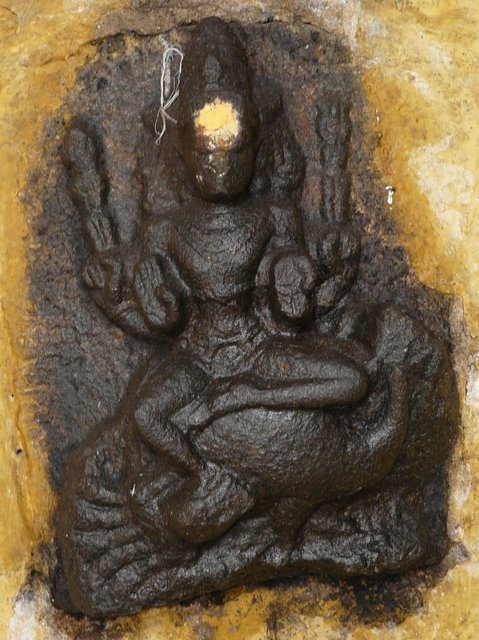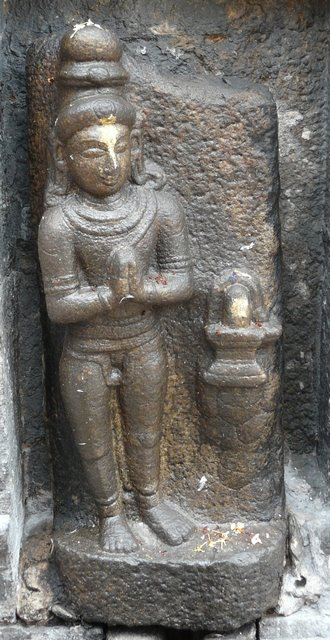
|
|
|
|
The Panchanadisvara Temple at Thiruvaiyaru is one of a group of seven temples, collectively known as the Saptha Sthaanam. They are associated with the marriage of Shiva's vahana, Nandi, and Shiva's role in the marriage pastime. Along with Thiruvaiyaru, the other temples include: Thiruchotruthurai, Thiruvedikudi, Thirupponduruthi, Thillaisthanam, Kandiyur, and Thiruppazhanam.
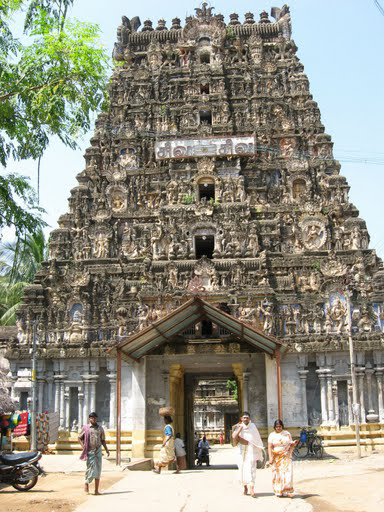
Temple Gopuram The 10th century Panchanadisvara Temple complex is divided into two distinct areas: Uttarakailasam and Dakshinakailasam. Uttarakailasam was built by Rajaraja Cholan's queen in the late 10th century, and she made several endowments for the temple. The Dakshinakailasam section was renovated by Rajendra Cholan's queen. Several inscriptions found in the temple refer to the Cholas, Pandyas, and other rulers, including Karikala Chola, Jatavarman Sundara Pandyan, and Krishna Devarayar. One of the Nayanmars, Appar, sang this temple.
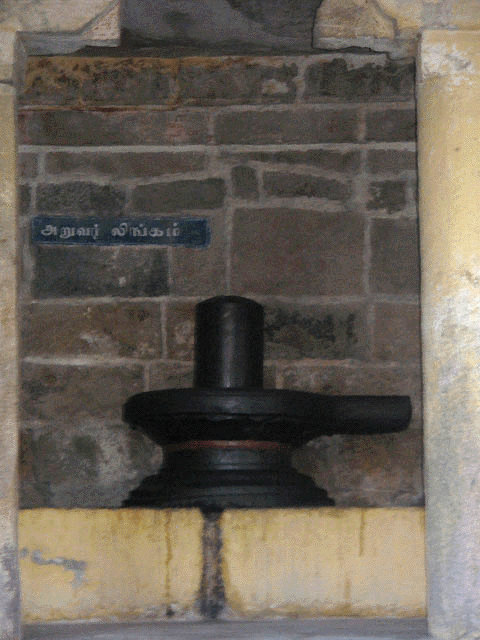
Shivalinga
There are several presiding deities here, including Lord Shiva in his forms as Panchanadisvara (Sanskrit, or Ayyaarappan in Tamil), Mahadhevar (Lokamahadesvarar), and Pranatharthiharar. In both Sanskrit and Tamil, Shiva's name means 'Lord of the Five Rivers'. Lord Shiva's consort here is Aramvalarththa nayaki (Parvati), known in Tamil as Dharma samvardhdhani, Tripurasundari, and Ulagudainachchiyar.
The secondary deities here include Chemporchodhi nathar (Lord Brahma), and Panychapakeshar (Ganesh). There is also a Dakshinamurthi.
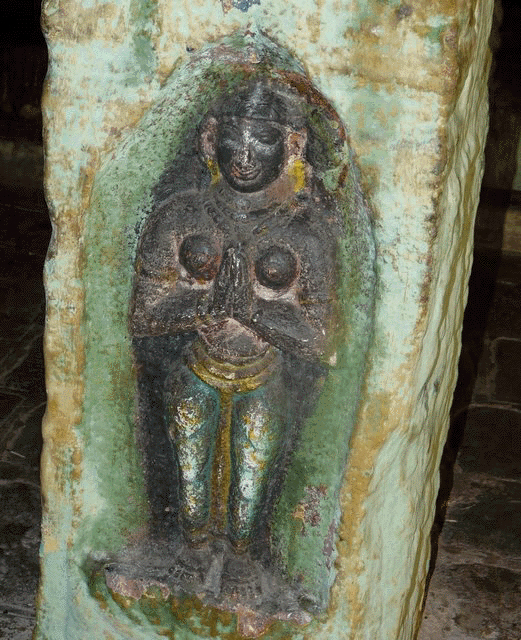
Devi The temple theerthams include the River Kaviri, Surya theertham, Nandi theertham, Samudra theertham, and Devamrita theertham. The Sthala Vriksha (sacred tree) is Vilvam. The abode is also known as Kavirikkottam.
In Vedic literature we find reference to the fact that some names for Lord Brahma end with the term 'natham' or 'nathar'. For example, Sathiya-nathar refers to Lord Brahma as the upholder of the principles of dharma. Here at Thiruvaiyaru, Brahmadeva is called Chemporchodhi-nathar. 'Chemporchodhi' appears to be a Tamil term.
Over the course of our research for this series, it has become apparent to us that the story of the curse against Lord Brahma, to only be permitted worship at Pushkar, has become legendary all across India. We have discovered many references where local villagers describe Brahma temples, shrines and murtis in somewhat hushed tones, suggesting that worship at these places is either subdued or avoided on account of the curse. Likewise, we have found instances where Brahma deities have been moved and renamed as other deities (usually Shiva), and our segment tomorrow will present just such a case, at a sister temple to Sri Panchanadisvara.
In some temples, a day of worship is conducted wherein a Shiva deity will be worshipped using names of Lord Brahma. The linga shape is sometimes associated with the egg-like nature of Lord Brahma's creation. These sorts of compromises are sometimes employed in place of outright worship of Lord Brahma, in his own form.
In some cases, we find that attributes of another divine personality have either been incorporated into a Brahma deity, or if not combined in the murti form, another deity's qualities are attributed to an actual Brahma deity. This may well be the case here at Thiruvaiyaru, where some consider the Brahma deity to be Subramanya, although numerous historical references exist which identify the deity as Lord Brahma.
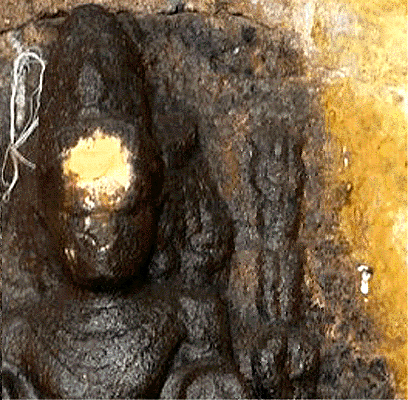
Chakra or Val? In the beautiful Brahma deity at Thiruvaiyaru, we see Brahmadeva seated on his vahana. Two of his hands are in mudra position, while the other two hold paraphernalia, which we identify to be conch and chakra. However, in the minds of some local devotees and followers of Subramanya, this deity is considered to be Subramanya seated on his peacock vahana. The implement held in the deity's upper left hand is considered to be Subramanya's Val, a triangular spear. While we can agree that the vahana's head looks somewhat peacock-like, we find the tail feathers to be much more typical of Hamsa than of a peacock. In addition, we do not see a great resemblance to the Val in this item of paraphernalia. Not only does the emblem not come to an upward point, like the Val typically does, it has a distinct circular form, like a chakra. The chakra, being associated with Lord Brahma's protection of Dharma, is paraphernalia we would except to see being held by Brahmadeva.
The temple complex at Sri Panchanadisvara is comprised of five prakarams (walls) and many mandapams, or halls. Devotees are not encouraged (or perhaps not permitted) to do pradakshinam of the temple, because it is believed that the holy locks of Lord Shiva's hair grow here.
In the sanctum sanctorum, the prakarams are covered with beautiful and brightly colored murals. Both the paintings and architecture are predominantly Chola.
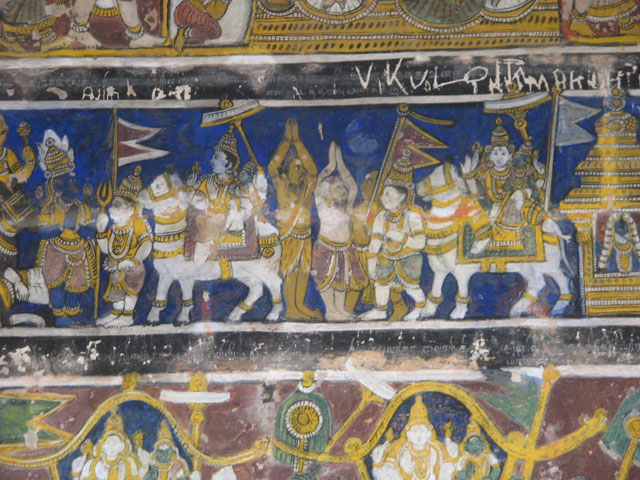
Temple Murals On entering the first courtyard, by the eastern gopura (gate), there is a shrine on the south side for Dakshina Kailas, which has beautiful pillars. On the north side is the Uttara Kailas shrine. The original construction of both these buildings was carried out, according to the Puranas, by Suratha Maharaja of the Lunar Race, while he was on pilgrimage from Hastinapur. The periyamandapam in the second courtyard was built later, but the original garbhaggriham (central shrine) dates back to the time of the Sage Neymesa. The third prakara has three large, oval footprints of a bull, in the south.
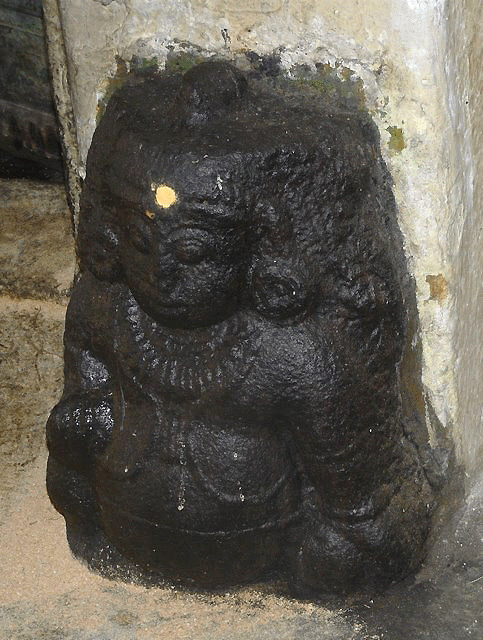
Shiva's Gana Outside, in the back of the temple complex, opposite from the southern entrance is a shrine to Shiva Alkondar, the kshetrapala god who is a very ugra deity wearing a garland of scorpions and poisonous creatures. Alkondar once punished Yama for attempting to take a young devotee. There is a large pit by the Alkondar shrine, and devotees take the smoke to remove the fear of death. The main temple tank, Surya Pushkarni, is quite large. While bathing in this tank, the elderly saint Tirunavukkarasar got darshan of Shiva on Mount Kailash. He sang the vision:
The story of how Panchanadisvara Temple came to be describes how a king’s chariot once got stuck in the mud. While digging to free the wheels of the chariot, a lingam was discovered. A wise minister advised them to dig further, but very carefully, and sure enough, the murtis of Dharmasamvardhini, Vinayaka, Muruga, and Nandi were all uncovered. More astonishing still, they also found a Siddhhar (saint), deep in meditation underground, the locks of his hair spread across the pit like banyan roots. The saint advised the king to build a temple at this place, instructing him to continue digging under the hooves of Nandi, where he would uncover the wealth needed to build the temple.
In the pastime memorialized by the Saptha Sthaanam, Nandi vahana was born into the care of Siladha Maharshi, and performed great penance to Shiva. Reciprocating, Shiva made Nandi his vahana, and arranged for his marriage at Thirumazhapadi, near Thiruvaiyaru. Shiva and Nandi traveled to the seven temples as part of the Sapthapadi. This pastime is commemorated with a festival each year, when Sri Panchanadisvara is taken out on a glass-encrusted palanquin from Thiruvaiyaru, making the rounds to the seven villages. At each one, the local presiding deity greets the party, accompanying Shiva to the next village.
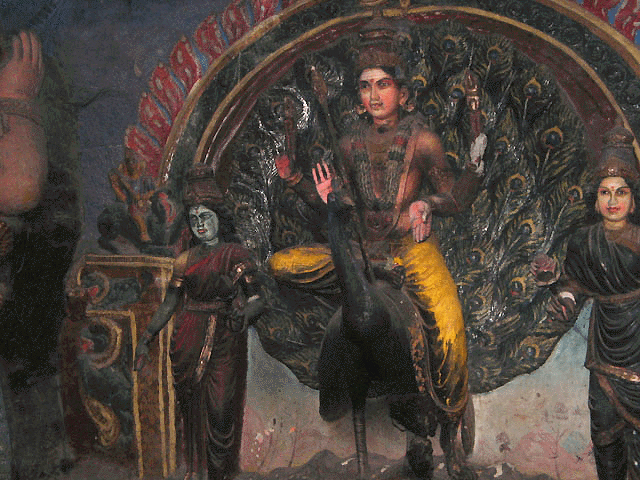
Subramanya utsavamurti (processional deity) Devotees throng to Panchanadisvara (Panchanatheeswar or Panchanadheesvarar) Temple year round, not only to take darshan of the deities and enjoy the festivals, but also because the town is associated with the Saint Thyagaraja, one of the trinity of masters in the field of Carnatic music. Near the temple is the small house where Thiyagaraja composed some of his greatest works. His samadhi is on the riverbank, and a great festival takes place there each year. Several important festivals are held at Panchanadisvara Temple, including Chiththirai Vishakam, Shivaratri, and Kalashtami, which is held in the month of Karthikai.
| |
